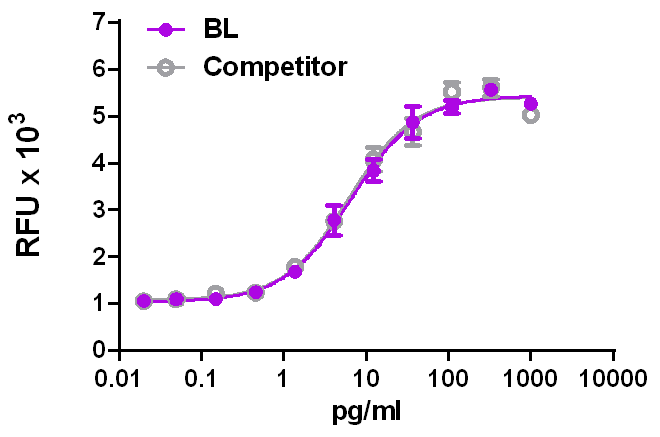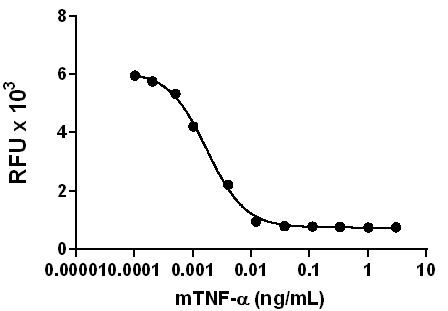- Regulatory Status
- RUO
- Other Names
- RP23-160G19.8, Il-1a
- Ave. Rating
- Submit a Review
- Product Citations
- publications
IL-1 was isolated from human blood that had been exposed to a pathogenic bacterium. IL-1 is a pyrogen, and it is an activating factor for lymphocytes. It also damaged joints and influenced liver proteins (3). IL-1α binds to the cell surface type I and II IL-1 receptors (IL-1RI and IL-1RII). IL-1 and -β and IL-1RA can compete for binding to these receptors. However, only IL-1RI, not IL-1RII, is functional because IL-1RII lacks a cytoplasmic domain and is thus unable to transmit signals to downstream steps (4). During ovarian inflammatory response, proinflammatory cytokine production such as IL-1 is augmented in granulosa cells and can induce local chemokine synthesis, which in turn may affect ovarian function (1). Also, IL-1 is involved in regulating tissue chemokine expression and leukocyte accumulation. The abundant influx of leukocytes into the ovary varies with the stage of the cycle and the leukocytes are thought to have a central role in influencing follicular atresia, ovulation, and luteal function and are potentially involved in ovarian disorders such as premature ovarian failure and polycystic ovary syndrome (1). IL-1a induces CXCl1 RNA and protein in mouse granulose cells.
Product DetailsProduct Details
- Source
- Mouse IL-1α, amino acids Ser115-Ser270 (Accession# NM_010554) was expressed in E. coli.
- Molecular Mass
- The 156 amino acid recombinant protein has a predicted molecular mass of 17,990 Da. The DTT-reduced and the non-reduced protein migrate at approximately 18kDa by SDS-PAGE. The N-terminal amino acid is Serine.
- Purity
- Purity is >98%, as determined by Coomassie stained SDS-PAGE.
- Formulation
- 0.22 µm filtered protein solution is in 10mM NaH2PO4, 150mM NaCl, pH 7.2.
- Endotoxin Level
- Endotoxin level is <0.1 EU/µg (<0.01ng/µg) protein as determined by the LAL method.
- Concentration
- 10 and 25 µg sizes are bottled at 200 µg/mL. 100 µg size and larger sizes are lot-specific and bottled at the concentration indicated on the vial. To obtain lot-specific concentration and expiration, please enter the lot number in our Certificate of Analysis online tool.
- Storage & Handling
- Unopened vial can be stored between 2°C and 8°C for up to 2 weeks, at -20°C for up to six months, or at -70°C or colder until the expiration date. For maximum results, quick spin vial prior to opening. The protein can be aliquoted and stored at -20°C or colder. Stock solutions can also be prepared at 50 - 100 µg/mL in appropriate sterile buffer, carrier protein such as 0.2 - 1% BSA or HSA can be added when preparing the stock solution. Aliquots can be stored between 2°C and 8°C for up to one week and stored at -20°C or colder for up to 3 months. Avoid repeated freeze/thaw cycles.
- Activity
- ED50 =1- 5 pg/ml, corresponding to a specific activity of 1- 0.2 x 109 units/mg, as determined by the dose dependent stimulation of D10S cells proliferation
- Application
-
Bioassay
- Recommended Usage
-
Use when high specific biological activity is required.
- Application Notes
-
This IL-1α protein is biologically active, and can be used for in vitro assays.
BioLegend carrier-free recombinant proteins provided in liquid format are shipped on blue-ice. Our comparison testing data indicates that when handled and stored as recommended, the liquid format has equal or better stability and shelf-life compared to commercially available lyophilized proteins after reconstitution. Our liquid proteins are verified in-house to maintain activity after shipping on blue ice and are backed by our 100% satisfaction guarantee. If you have any concerns, contact us at tech@biolegend.com. -
Application References
(PubMed link indicates BioLegend citation) -
- Lee PY, et al. 2011. J. Immunol. 186:1747. PubMed
- Product Citations
-
Antigen Details
- Structure
- Cytokine
- Distribution
-
IL-1α is produced by monocytes, macrophages, keratinocytes, stimulated B lymphocytes, fibroblasts, endothelial cells, and epithelial cells. In addition, IL-1α is localized in various ovarian cell types such as the oocyte, granulosa, and theca cells, and ovarian cancer cells (1).
- Function
- The cytokine IL-1α is a key molecule both in the innate and in the adaptive immune response. IL-1α induces autonomous proliferation in vascular smooth muscle cells, T cell activation during Ag presentation, up-regulation of monocyte/macrophage-mediated tumor cytotoxicity, stimulation of osteoclast formation, and expression of Cxcl1 (kC) chemokine mRNA and protein in mouse granulosa cells (1,2).
- Ligand/Receptor
- Type I and II IL-1 receptors (IL-1RI and IL-1RII)
- Cell Type
- Hematopoietic stem and progenitors
- Biology Area
- Cell Biology, Immunology, Stem Cells
- Molecular Family
- Cytokines/Chemokines
- Antigen References
-
1. Soo DS and Roby KF, et al. Mol Endocri 20:2999-3013 2006.
2. Yatabe T, et al. Ann Rheum Dis published online 28 Jul 2008.
3. Ledford H et al, Nature 450:29-30 2007.
4. Boraschi B Tagliabue A et al, Vitam Horm 74:229-254 2006. - Gene ID
- 16175 View all products for this Gene ID
- UniProt
- View information about IL-1alpha on UniProt.org
Related FAQs
- Why choose BioLegend recombinant proteins?
-
• Each lot of product is quality-tested for bioactivity as indicated on the data sheet.
• Greater than 95% Purity or higher, tested on every lot of product.
• 100% Satisfaction Guarantee for quality performance, stability, and consistency.
• Ready-to-use liquid format saves time and reduces challenges associated with reconstitution.
• Bulk and customization available. Contact us.
• Learn more about our Recombinant Proteins. - How does the activity of your recombinant proteins compare to competitors?
-
We quality control each and every lot of recombinant protein. Not only do we check its bioactivity, but we also compare it against other commercially available recombinant proteins. We make sure each recombinant protein’s activity is at least as good as or better than the competition’s. In order to provide you with the best possible product, we ensure that our testing process is rigorous and thorough. If you’re curious and eager to make the switch to BioLegend recombinants, contact your sales representative today!
- What is the specific activity or ED50 of my recombinant protein?
-
The specific activity range of the protein is indicated on the product datasheets. Because the exact activity values on a per unit basis can largely fluctuate depending on a number of factors, including the nature of the assay, cell density, age of cells/passage number, culture media used, and end user technique, the specific activity is best defined as a range and we guarantee the specific activity of all our lots will be within the range indicated on the datasheet. Please note this only applies to recombinants labeled for use in bioassays. ELISA standard recombinant proteins are not recommended for bioassay usage as they are not tested for these applications.
- Have your recombinants been tested for stability?
-
Our testing shows that the recombinant proteins are able to withstand room temperature for a week without losing activity. In addition the recombinant proteins were also found to withstand four cycles of freeze and thaw without losing activity.
- Does specific activity of a recombinant protein vary between lots?
-
Specific activity will vary for each lot and for the type of experiment that is done to validate it, but all passed lots will have activity within the established ED50 range for the product and we guarantee that our products will have lot-to-lot consistency. Please conduct an experiment-specific validation to find the optimal ED50 for your system.
- How do you convert activity as an ED50 in ng/ml to a specific activity in Units/mg?
-
Use formula Specific activity (Units/mg) = 10^6/ ED50 (ng/mL)

 Login / Register
Login / Register 














Follow Us